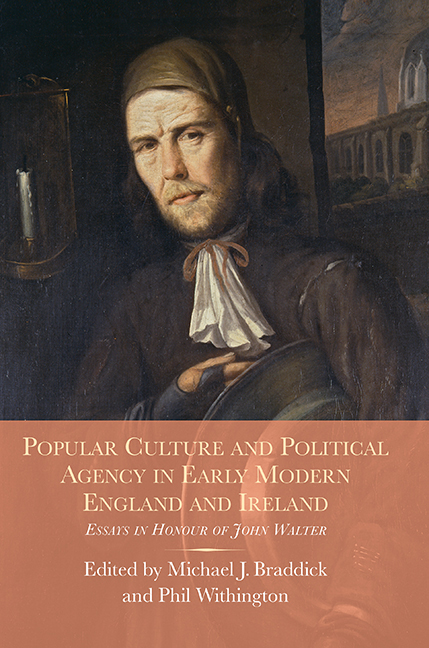 Popular Culture and Political Agency in Early Modern England and Ireland
Popular Culture and Political Agency in Early Modern England and Ireland Book contents
- Frontmatter
- Contents
- List of Illustrations
- List of Contributors
- Acknowledgements
- List of Abbreviations
- Introduction
- 1 John Walter and the social history of early modern England
- 2 Contrasting susceptibility to famine in early fourteenth- and late sixteenth-century England: the significance of late medieval rural social structural and village governmental changes
- 3 The politics of English political economy in the 1620s
- 4 Provision, household management and the moral authority of wives and mothers in early modern England
- 5 Popular senses of past time: dating events in the North Country, 1615–1631
- 6 Spectral lordship, popular memory and the boggart of Towneley Hall
- 7 Self-image and public image in the career of a Jacobean magistrate: Sir John Newdigate in the Court of Star Chamber
- 8 Gender, agency and religious change in early Stuart England
- 9 ‘A Standard which can never fail us’: the Golden Rule and the construction of a public transcript in early modern England
- 10 Religion, anti-popery and corruption
- 11 An ‘Aristotelian moment’: democracy in early modern England
- 12 John Lilburne and political agency in revolutionary England
- 13 An Irish Protestation? Oaths and the Confederation of Kilkenny
- 14 ‘Whereat his wife tooke great greef & died’: dying of sorrow and killing in anger in seventeenth-century Ireland
- Bibliography for John Walter
- Index
- Tabula Gratulatoria
- Miscellaneous Endmatter
5 - Popular senses of past time: dating events in the North Country, 1615–1631
Published online by Cambridge University Press: 09 May 2017
- Frontmatter
- Contents
- List of Illustrations
- List of Contributors
- Acknowledgements
- List of Abbreviations
- Introduction
- 1 John Walter and the social history of early modern England
- 2 Contrasting susceptibility to famine in early fourteenth- and late sixteenth-century England: the significance of late medieval rural social structural and village governmental changes
- 3 The politics of English political economy in the 1620s
- 4 Provision, household management and the moral authority of wives and mothers in early modern England
- 5 Popular senses of past time: dating events in the North Country, 1615–1631
- 6 Spectral lordship, popular memory and the boggart of Towneley Hall
- 7 Self-image and public image in the career of a Jacobean magistrate: Sir John Newdigate in the Court of Star Chamber
- 8 Gender, agency and religious change in early Stuart England
- 9 ‘A Standard which can never fail us’: the Golden Rule and the construction of a public transcript in early modern England
- 10 Religion, anti-popery and corruption
- 11 An ‘Aristotelian moment’: democracy in early modern England
- 12 John Lilburne and political agency in revolutionary England
- 13 An Irish Protestation? Oaths and the Confederation of Kilkenny
- 14 ‘Whereat his wife tooke great greef & died’: dying of sorrow and killing in anger in seventeenth-century Ireland
- Bibliography for John Walter
- Index
- Tabula Gratulatoria
- Miscellaneous Endmatter
Summary
On 27 March 1642, according to George Naworth's New Almanacke and Prognostication calculated for the ‘Meridian and Latitude of the ancient City of Durham’, the sun would rise at 5.14 a.m. precisely. (He told his readers to ‘expect windy cold and open weather’.) Moreover, his ‘Computation of time complete to this present year’ informed them that 1642 would be 5591 years ‘since the Creation of the World’, 2461 years ‘Since England received the Christian Faith’, and 576 ‘Since the Conquest of England by William Duke of Normandy’. Of more local interest, it would be 647 years ‘Since Durham was built’, 242 ‘Since the building of the bridge at Aukland’ by Bishop Skirlaw, and 73 ‘Since the Rebellion of the Earles of Northumberland and Westmerland’. More recently, it was 54 years ‘Since the camp at Tilbury in Essex’, 37 ‘Since the Gunpowder Treason’, and 19 ‘Since his Majesties returne from Spain’. It was 17 years since ‘Charles our King began his raigne’ on 17 March 1625, and a list of the exact regnal years of Charles's predecessors since the Conquest was supplied elsewhere.
As all this indicates, Naworth, like other compilers of almanacs, had a highly sophisticated grasp of astronomical and calendrical time. If he was attentive to the movements of the heavenly bodies and the cycle of the seasons, he also had a firm conception of time as linear, continuous, regular and measurable: evenly divided into minutes, hours, days, weeks, months and years. As a self-proclaimed ‘Student in the Mathematicks’, he was preoccupied with chronological exactitude: one of those authors of almanacs who, as Daniel Woolf puts it, were engaged in ‘the homogenization of time’, in the construction of timelines of events which served ‘to fix the past, to objectify it independent of the powers of human memory’, and ultimately to contribute to a standardised and chronologically rigorous ‘national sense of the past’.
Naworth 's, however, was only one way of thinking about time and ordering events, albeit perhaps the one with which we have become most familiar. As has often been observed, there are many ways of mapping time, many ‘temporal frameworks ’, ‘time senses ’, and forms of ‘time consciousness ’. There are many forms of ‘temporal experience ’, and many levels of ‘temporal skills ’.
- Type
- Chapter
- Information
- Popular Culture and Political Agency in Early Modern England and IrelandEssays in Honour of John Walter, pp. 91 - 108Publisher: Boydell & BrewerPrint publication year: 2017


